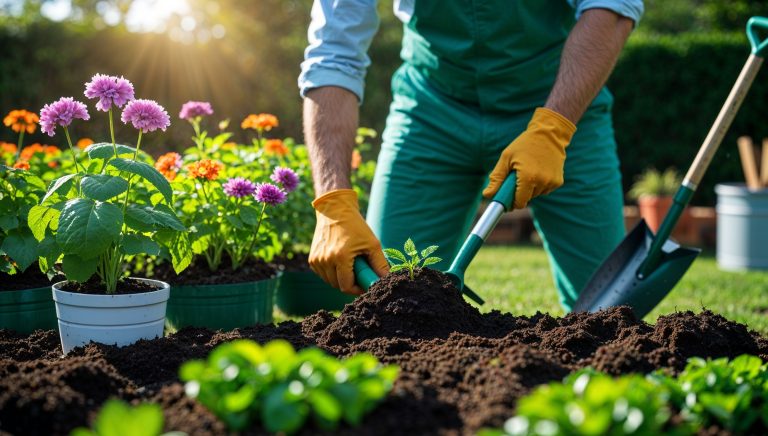

Gardening is a rewarding and fulfilling hobby, but maintaining a garden that remains vibrant and beautiful throughout the year requires effort and a little planning. From winter’s frost to the scorching heat of summer, each season presents unique challenges and opportunities for your garden. Whether you’re tending to flowers, vegetables, or herbs, you can take specific steps to ensure that your garden flourishes year-round. In this article, we’ll guide you through the essential tasks to keep your garden looking its best no matter the time of year.
A key aspect of maintaining a beautiful garden year-round is preparing for seasonal changes. Each season brings different weather conditions, and understanding how these changes affect your plants allows you to adjust your care routines. Planning ahead will help you ensure that your garden remains healthy and vibrant from season to season.
Spring is a season of renewal, and it’s the perfect time to start fresh with your garden. As temperatures rise and daylight hours increase, plants begin to break dormancy and grow actively. It’s time to clean up the garden, remove any dead plants from the previous season, and prepare for new growth.
Spring is the best time to plant new flowers, shrubs, and vegetables. It’s a season full of promise, where your hard work will begin to bear fruit.
Summer is often the most demanding season for gardeners. With longer days and hotter temperatures, your plants need extra attention to stay healthy and vibrant. The key to maintaining a beautiful garden during the summer is consistent care, especially in terms of watering and pest control.
Summer requires consistent maintenance, but it’s the season when your garden truly shines, filled with lush growth and vibrant colors.
As the weather cools in the fall, the gardening focus shifts toward preparation for winter. Many plants slow down or go dormant, and it’s important to help them prepare for the colder months ahead.
Fall is the time to get your garden ready for winter, so it can bounce back stronger and more beautiful in the spring.
Winter can be tough on plants, especially in regions that experience freezing temperatures. However, with the right care, your plants can survive the winter months and be ready to thrive again when the warmth of spring arrives.
Winter is a season of rest for your garden, but with the proper preparation, your plants will be ready to spring to life once again.
Watering and fertilization are essential year-round tasks for maintaining a beautiful garden. Proper watering ensures that your plants stay hydrated and healthy, while fertilizing provides the nutrients they need to grow and thrive.
The frequency of watering depends on the season, weather conditions, and the types of plants in your garden.
Fertilizing your plants provides essential nutrients that promote healthy growth. The type of fertilizer you use and how often you apply it depends on the plants in your garden.
Weeds compete with your plants for water, nutrients, and sunlight. Controlling weeds is essential to maintaining a healthy garden throughout the year.
Mulching is one of the most effective ways to prevent weeds from taking over your garden. Apply a thick layer of organic mulch around your plants to block sunlight and prevent weed seeds from germinating. Mulch also helps to retain soil moisture and keeps the roots of your plants insulated.
Although mulch helps reduce the growth of weeds, it’s still important to inspect your garden regularly and remove any weeds that do appear. Hand-pull or use a hoe to dig out weeds at their roots to prevent them from regrowing.
Pruning and deadheading are crucial tasks that ensure your garden remains tidy and encourages new growth.
Pruning involves cutting back dead, damaged, or overgrown branches and stems to promote healthy growth. It helps improve air circulation, reduce disease risks, and enhance the overall shape of your plants. Use sharp pruning shears to make clean cuts, and avoid cutting into healthy growth.
Deadheading, or removing spent flowers, is a simple yet effective way to encourage more blooms. By removing faded flowers, you prevent the plant from wasting energy on producing seeds, allowing it to focus on producing new flowers.
Pests and diseases can quickly damage your garden, so regular inspections are essential.
Use natural pest control methods to minimize damage to your plants. Introduce beneficial insects like ladybugs to your garden, which can help control aphids and other pests. Additionally, neem oil or insecticidal soap can effectively treat infestations without harming beneficial insects.
Diseases like powdery mildew and black spot can spread quickly if left unchecked. Prevent disease by ensuring good air circulation around your plants and removing any infected leaves promptly. If necessary, use fungicides or organic treatments to keep your plants healthy.
Planting the right plants at the right time ensures that your garden remains vibrant throughout the year.
Plant seasonal flowers like sunflowers, petunias, and geraniums in the spring for a vibrant, colorful garden. Summer vegetables such as tomatoes, cucumbers, and peppers thrive in the warm months.
In the fall, plant cold-hardy vegetables such as kale, spinach, and Brussels sprouts. You can also plant spring-blooming bulbs like daffodils, crocuses, and tulips to ensure your garden will bloom as soon as the weather warms up.